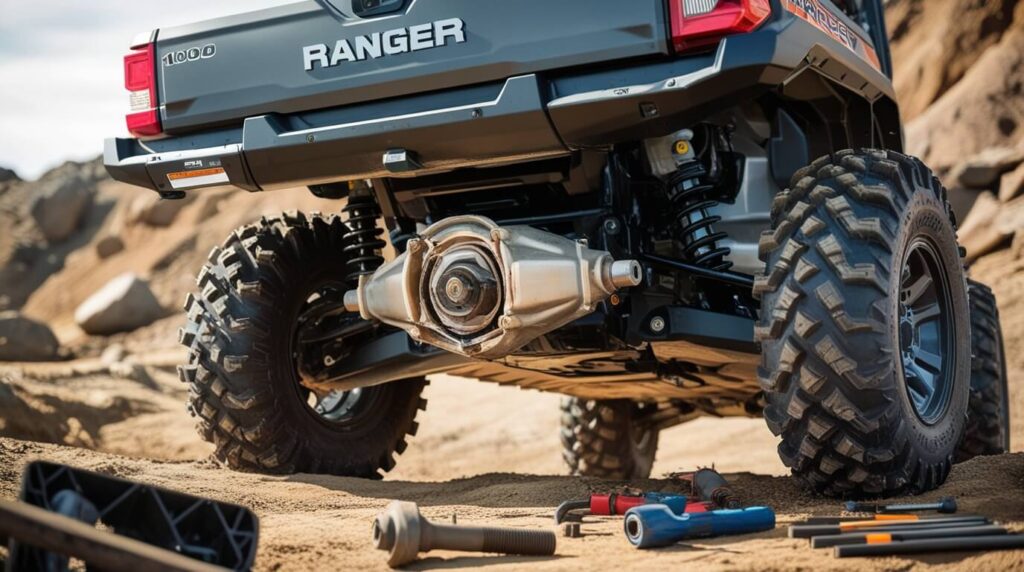The most common Polaris Ranger 800 XP problems are starting issues, brake problems, clutch issues, hard to shift, fuel pump problems, electrical problems, engine overheating, engine misfire, locking differential issues, suspension problems and PTO issues.
Here we explore these problems in detail and provide easy solutions to them.
Polaris Ranger 800 XP problems and Solutions
Here are the most common problems of Polaris Ranger 800 XP that you might face on offroading.
1. Starting Problems
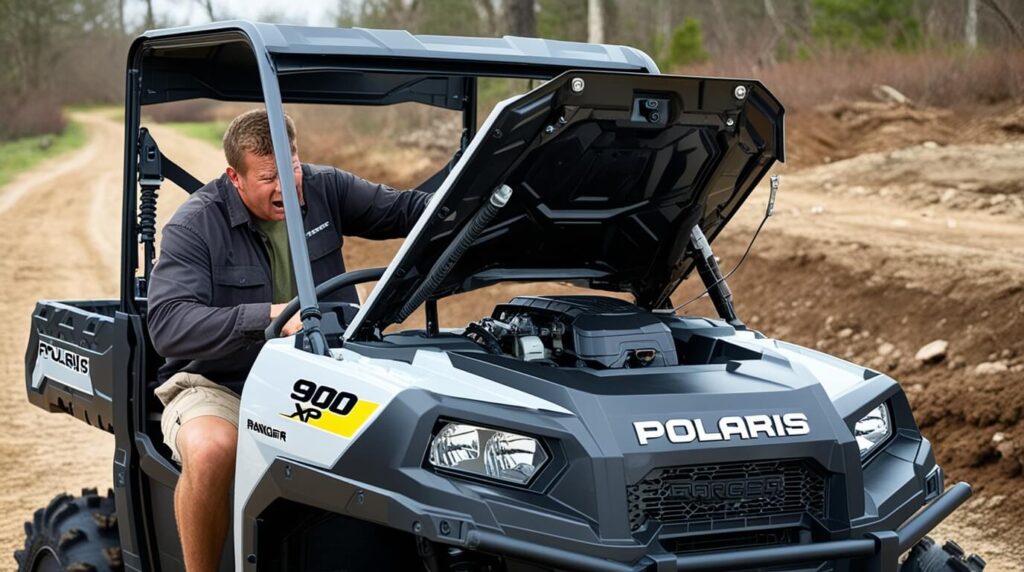
Experiencing starting issues with your Polaris Ranger 800 XP can be a frustrating ordeal.
Common symptoms include the engine not turning over, strange noises when the ignition is turned on, or even a complete absence of response.
These problems can stem from several causes, ranging from battery issues to starter motor failures. Knowing the right reasons behind these problems can be the first step towards finding effective solutions.
Common Causes of Starting Problems
One of the primary causes of starting issues is a weak or dead battery.
Batteries typically have a lifespan of about 3-5 years; if the battery is older than this, it may no longer hold a charge effectively.
Other potential culprits include faulty ignition switches, corroded battery terminals, or issues with the starter solenoid.
Sometimes, fuel delivery problems can also contribute to difficulties in starting, though this is less common.
Also explore the Polaris Ranger Years to Avoid
Solutions
To address a weak battery, it is advisable to jump-start the vehicle or replace the battery entirely if it’s worn out. Checking and cleaning the battery terminals can also help ensure a stronger connection.
If the problem lies elsewhere, inspecting the ignition switch and starter solenoid for any faults will provide further insights.
In cases of suspected fuel delivery issues, examining the fuel lines and ensuring there’s enough fuel in the tank could clear up starting problems.
Diagnosing these problems methodically can ensure that getting your Polaris Ranger back on the road is a straightforward process.
Also explore the Polaris Ranger 1000 problems
2. Polaris Ranger 800 XP Brake Problems

When operating a Polaris Ranger 800 XP, brake issues can pose serious risks. Recognizing the symptoms early can prevent larger problems.
Common signs include a spongy brake pedal, unusual noises when braking, or a delay in response. These symptoms often indicate that your brakes are wearing out or that there is an issue with the brake fluid or lines.
Common Causes of Brake Failure
There are several causes behind brake problems that you might experience. Worn brake pads are frequently the main culprit. If you notice that your brake pads have become thin or uneven, it’s time for a replacement.
Additionally, air in the brake lines can lead to reduced braking power. This often happens if there’s a leak in the hydraulic system, allowing moisture or air to compromise the fluid’s effectiveness.
Solutions
When tackling brake issues, there are solutions that can restore your vehicle’s functionality.
Start by inspecting the brake pads; if they are worn, replace them to ensure safe operation. In case of air in the brake lines, you may need to bleed the brakes to remove trapped air.
Regular maintenance is key—checking brake fluid levels and replacing it as necessary can help prevent future problems. Following these steps not only enhances your vehicle’s safety but also extends its lifespan.
3. Fuel Pump Problems
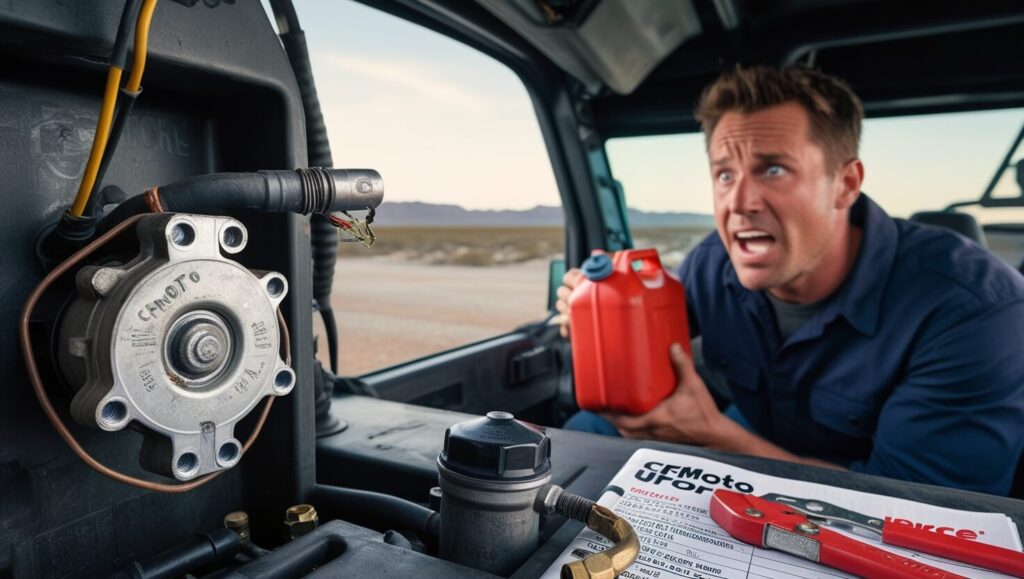
If you own a Polaris Ranger 800 XP, you might encounter some common fuel pump issues that hinder performance.
These problems often manifest as engine stalling, difficulty starting, or a noticeable decrease in power while driving. Understanding the symptoms is crucial for quick diagnosis.
Common Symptoms to Look For
When you face fuel pump issues, the symptoms can vary. You may notice that your vehicle struggles to start or requires multiple attempts before the engine fires up.
Additionally, if there is an unusual increase in fuel consumption or noticeable sputtering during acceleration, it could indicate that the fuel pump is not delivering the necessary pressure.
It’s essential to pay attention to these signs, as they can significantly impact your riding experience.
Possible Solutions and Repairs
To address these fuel pump problems effectively, the first step is to inspect the fuel pump relay and fuel lines for any signs of damage or leaks. If everything appears intact, you may need to replace the fuel pump itself.
Fortunately, installing a new fuel pump isn’t overly complicated. Many individuals choose to do this as a DIY project, saving on repair costs. Always ensure you have the correct replacement part for your specific model.
Regular maintenance checks will also help in identifying potential issues before they escalate, contributing to the overall longevity of your UTV.
4. Polaris Ranger 800 XP Shifting Problems
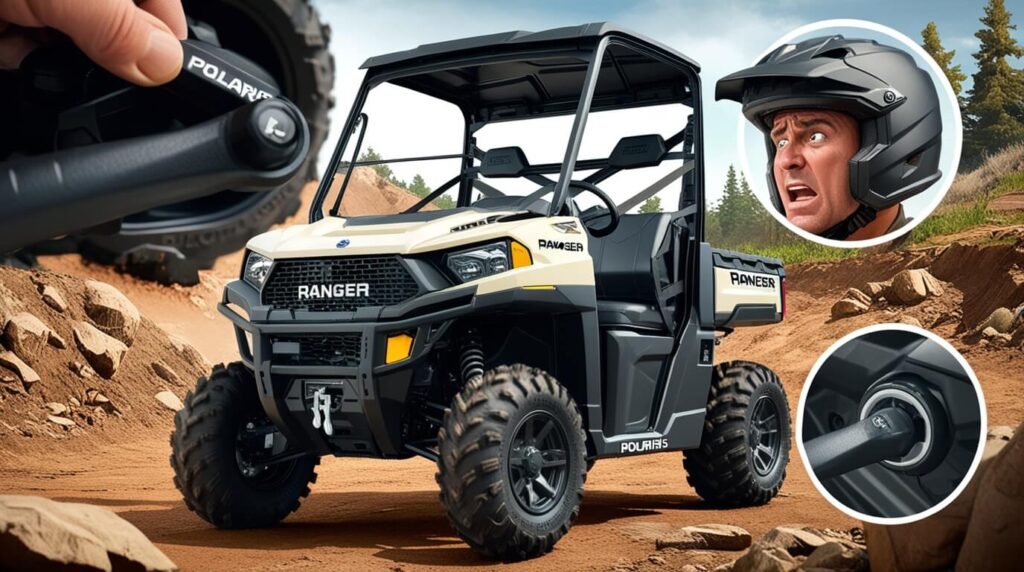
The Polaris Ranger 800 XP is known for its versatility and performance, but shifting problems can arise, causing frustration.
Common symptoms include difficulty in shifting gears, unusual noises during gear transitions, and grinding when changing from one gear to another.
These issues may stem from various causes, including low transmission fluid levels, worn clutch components, or misaligned cables.
Also explore the Polaris 900 xp Ranger Problems
Common Causes of Shifting Issues
You might find that low transmission fluid is a frequent culprit. It’s essential to check fluid levels regularly as they can degrade over time.
Worn or damaged clutch components can also lead to insufficient engagement, resulting in severe shifting problems.
Additionally, misalignment of the gear cables may hinder smooth transitions and limit your ability to shift gears seamlessly, impacting the overall driving experience.
Solutions
Resolving shifting issues often begins with checking the transmission fluid level. If low, refill it with the appropriate type specified in your owner’s manual.
For issues related to the clutch, consider replacing worn components or adjusting the cable tension to ensure proper engagement.
If misalignment is suspected, inspect the cables for any damage and realign them as necessary. Carrying out regular maintenance not only addresses current problems but can also prevent future issues, ensuring your Polaris Ranger operates smoothly.
5. Clutch Problems
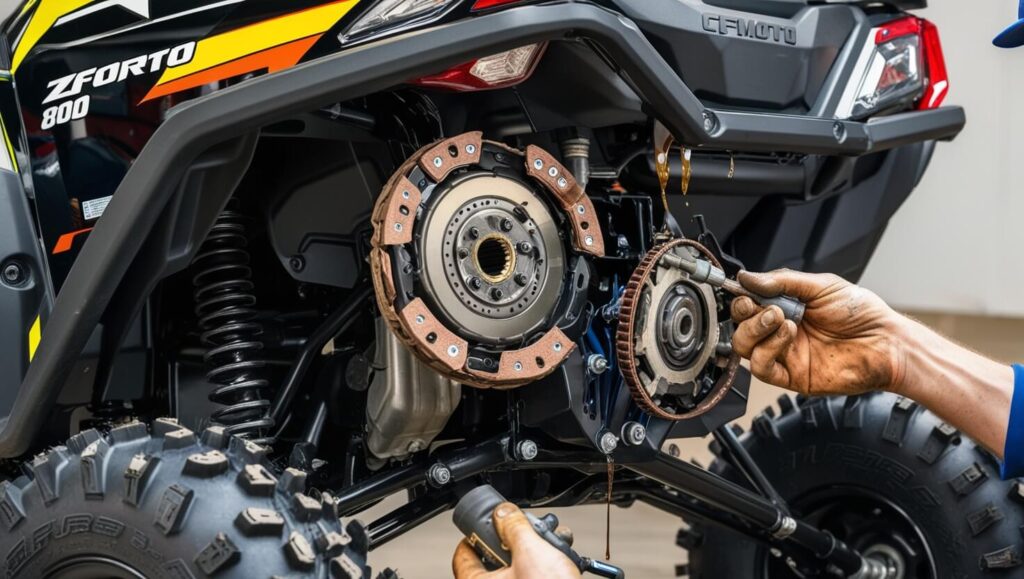
If you own a Polaris Ranger 800 XP, it’s essential to be aware of potential clutch issues that could arise. Common symptoms include strange noises from the clutch, delayed acceleration, or unusual vibrations when driving.
These problems may indicate wear and tear on your clutch components, frequently caused by prolonged use or lack of maintenance. Being proactive about these symptoms is crucial for preventing further damage.
Causes Behind Clutch Issues
Several factors contribute to clutch problems in the Polaris Ranger 800 XP. One of the primary causes is poor lubrication, which can lead to overheating and ultimately, clutch failure.
Another frequent culprit is the accumulation of debris in the clutch assembly, affecting its performance. It is also worth noting that incorrect installation of parts or using incompatible components may lead to recurring clutch issues.
Recognizing the causes will help you understand the importance of regular maintenance and inspections.
Solutions
Addressing clutch problems often requires a methodical approach.
First, ensure proper lubrication by regularly checking and replacing fluids as needed. Cleaning the clutch assembly to remove any debris or contaminants can greatly improve performance.
If more severe damage is evident, consulting a professional mechanic for parts replacement might be necessary.
Remember, regular maintenance checks can help catch these issues early, saving you from extensive repairs down the road.
By staying informed about these concerns and their solutions, you can ensure your Polaris Ranger 800 XP performs optimally and lasts longer.
6. Electrical Issues
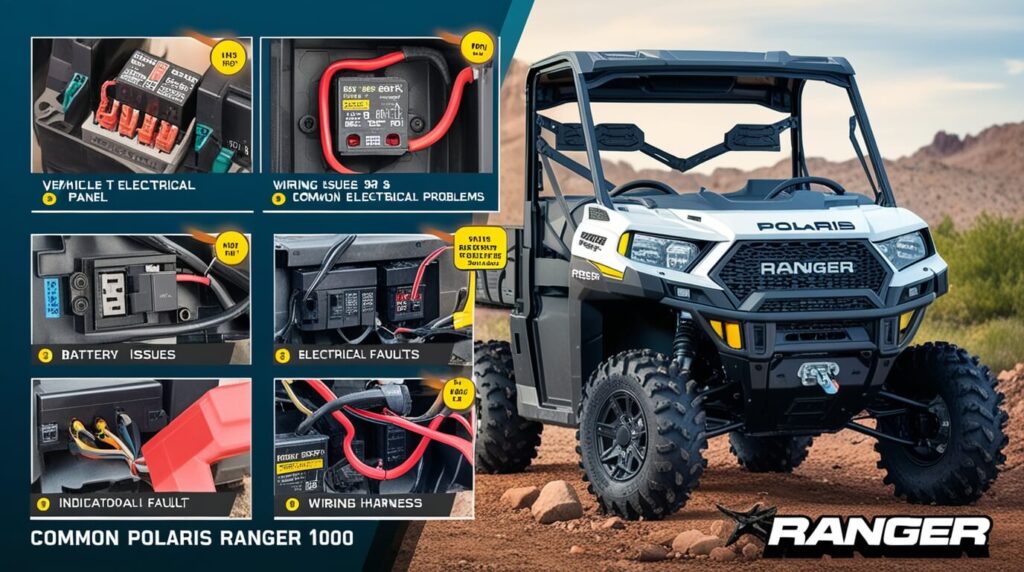
If you’re a proud owner of a Polaris Ranger 800 XP, you may encounter various electrical problems over time.
These issues can hinder performance and reliability, causing concern for users. Being aware of the common problems, their symptoms, and available solutions can make a significant difference.
Common Causes and Symptoms
One of the most prevalent electrical problems faced in the Polaris Ranger 800 XP is battery failure. You might notice dimming headlights or slow cranking when starting the engine, indicating a weakened battery.
Additionally, issues such as blown fuses could manifest as non-functional components, like the lights or accessories. Sometimes, you may experience faulty wiring – a common culprit for intermittent electrical failures or complete loss of power.
Solutions
Resolving these electrical issues in your Polaris Ranger 800 XP is crucial for maintaining its longevity.
For battery-related concerns, it’s advisable to inspect the battery regularly and replace it if it shows signs of wear. Checking and replacing any blown fuses is also straightforward; just refer to the owner’s manual for proper fuse ratings.
If you suspect wiring issues, visual inspections can help identify frayed or corroded wires. Using electrical tape to secure loose connections or replacing faulty wires entirely ensures safe operation.
By staying proactive and taking immediate action to address these common electrical problems, you can keep your Polaris Ranger running smoothly and efficiently.
7. Overheating Issue
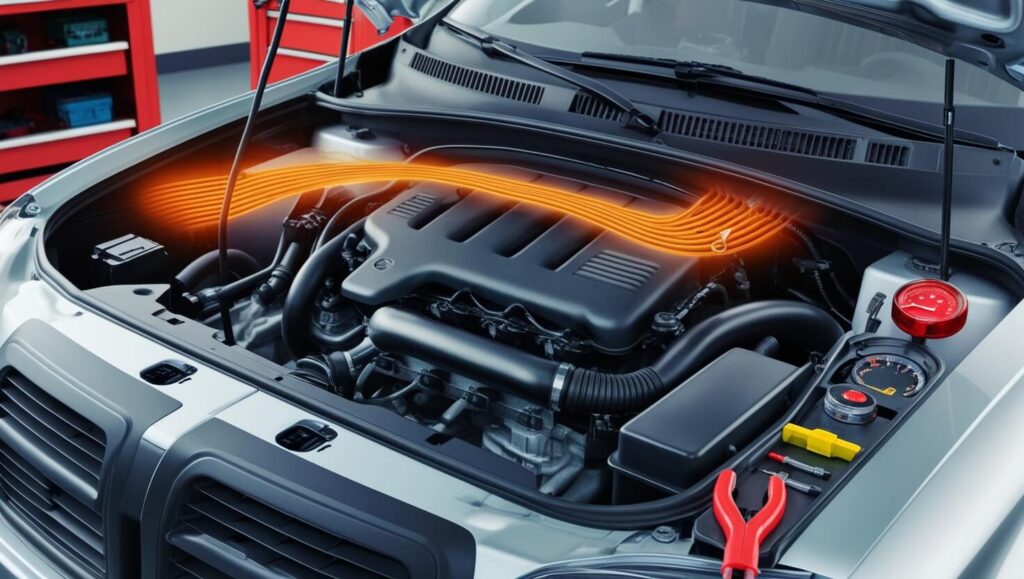
You may find yourself facing the frustrating problem of your Polaris Ranger 800 XP engine overheating. This issue can significantly impact your off-road adventures. It is essential to identify the symptoms early to prevent severe engine damage.
Common signs include steam rising from the engine compartment, the engine temperature gauge reaching the red zone, and unusual performance drops. Recognizing these symptoms can save you from costly repairs down the line.
Key Causes of Overheating
There are several factors that can contribute to your Polaris Ranger’s engine overheating. One of the most common causes is a low coolant level, which can be caused by leaks or evaporation.
Also, a malfunctioning thermostat can prevent proper coolant flow, leading to engine overheating.
Poor ventilation due to blocked air intakes can exacerbate heat buildup. Regularly inspecting these components can help you identify potential problems before they escalate.
Effective Solutions to Cool Down Your Engine
When confronted with engine overheating, immediate action is vital to restore your vehicle’s performance. Start by checking and topping off the coolant level to ensure optimal engine operation.
If the thermostat is not functioning correctly, consider replacing it. Regular maintenance of your air intakes and ensuring they’re free from debris will also promote efficient cooling.
If the problem persists despite your efforts, consulting a professional mechanic may be necessary. They can conduct a thorough inspection to determine if there are any underlying issues, ensuring your Polaris Ranger continues to perform reliably.
8. Engine Misfire
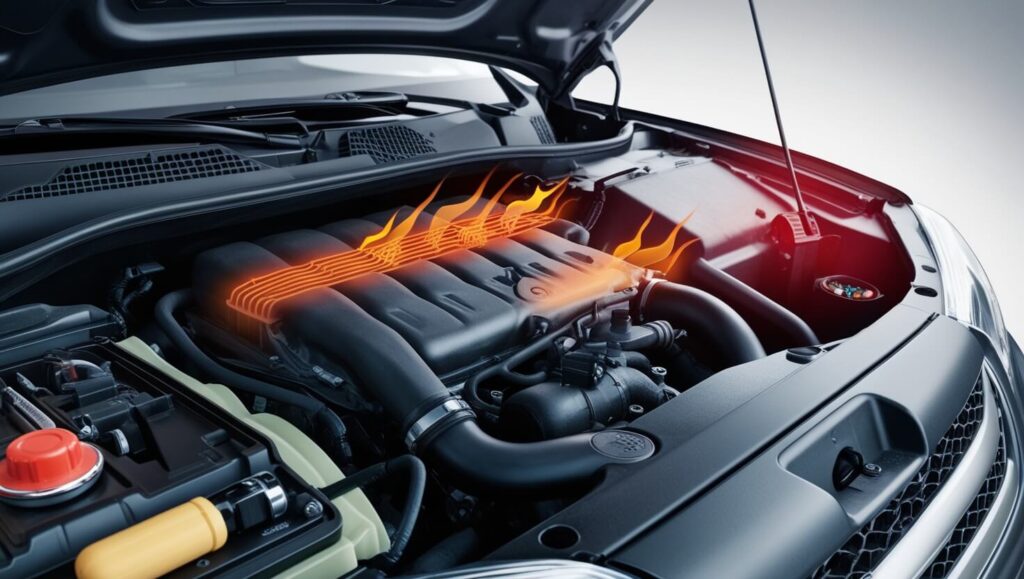
If you’re experiencing engine misfire issues with your Polaris Ranger 800 XP, you’re not alone. A misfire occurs when an engine’s fuel-air mixture fails to ignite properly, often leading to a rough running engine.
Common causes include faulty spark plugs, ignition coils, or even issues with fuel delivery such as clogged fuel filters or injectors. Additionally, problems with the engine’s sensors can disrupt the ignition timing, contributing to the misbehavior.
Identifying the Symptoms of a Misfire
Recognizing the symptoms of a misfire can be crucial in addressing the problem early on. You might notice a loss of power, a decrease in fuel efficiency, or unusual vibrations during operation.
The engine may hesitate or stumble during acceleration, and in severe cases, the check engine light could illuminate. If you observe these signs, it’s essential to take action sooner rather than later to prevent further damage.
Solutions
Fortunately, there are practical solutions to resolve the misfire issue. Start by inspecting and replacing the spark plugs and ignition coils if needed, as they are common culprits. It’s also a good idea to clean or replace the fuel filter and inspect fuel injectors for blockages.
Ensure that the engine sensors are functioning correctly, as an issue in these can lead to incorrect timing adjustments.
Regular maintenance, including tuning and checking the overall engine health, can also drastically reduce the chances of misfires occurring in the future. By addressing these issues promptly, you can restore your Polaris Ranger 800 XP to its optimal performance.
9. Locking Differential Problems
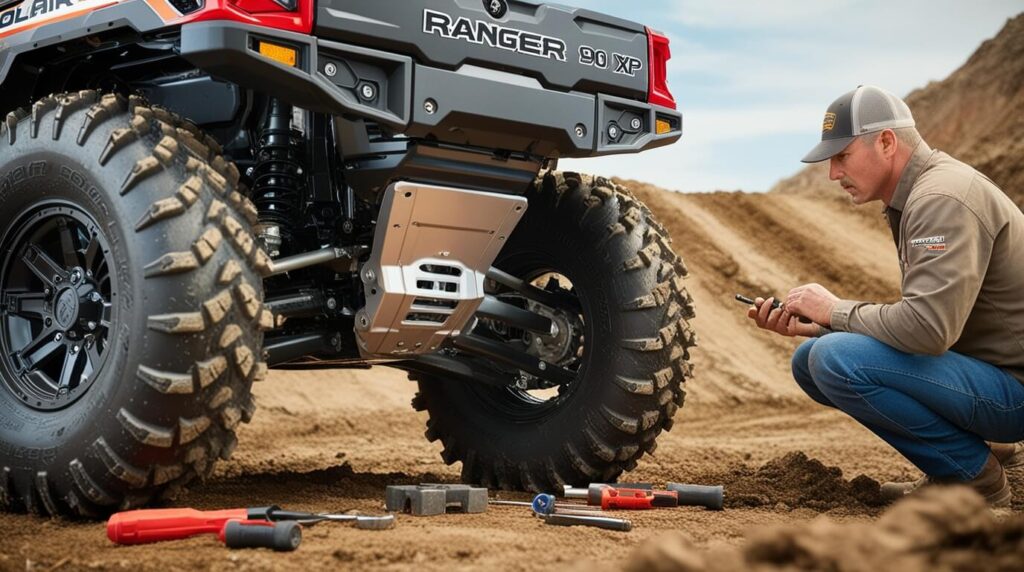
When using the Polaris Ranger 800 XP, one common issue that can arise is problems with the locking differential.
Symptoms may begin with irregular noises from the drive train while in operation or difficulty in switching between two-wheel and four-wheel drive modes.
You might notice that the vehicle struggles to gain traction when navigating muddy or hilly terrains, indicating a problem with the locking differential.
Causes Behind These Issues
Several factors can lead to locking differential problems in your Polaris Ranger 800 XP. One frequent cause is the wear and tear of components due to extended use without proper maintenance.
Dirt and grime can seep into the differential, degrading its performance. Another cause can be a malfunctioning actuator that fails to engage or disengage the locker correctly, leading to excessive strain on the drivetrain.
Solutions
There are effective solutions to address these locking differential challenges. Begin by inspecting the differential fluid levels, as low fluid can lead to overheating and component failure.
Regular maintenance and cleaning can help prevent dirt buildup and extend the differential’s life. If the actuator is malfunctioning, it may need to be replaced or repaired.
Always consult your owner’s manual for specific troubleshooting tips or consider reaching out to a qualified mechanic to ensure proper handling of the issue.
10. Polaris Ranger 800 XP Suspension Problems
If you own a Polaris Ranger 800 XP, you may have encountered some suspension issues that can significantly affect your ride quality.
Common problems include a sagging suspension, excessive bounce, or even unexpected noises while traversing rough terrains. These symptoms often indicate wear and tear or misalignment that needs addressing to ensure a safe and comfortable ride.
Identifying Symptoms of Suspension Failure
To diagnose suspension problems accurately, observe how your Polaris Ranger handles. If you notice the vehicle leaning excessively when turning or a rough ride even on smooth paths, it could point to deteriorating suspension components.
Other symptoms may include uneven tire wear or an inability to maintain stability on inclines. Addressing these issues early can prevent more severe damage and costly repairs down the line.
Solutions
For those experiencing these suspension problems, several solutions can restore your Ranger’s performance.
Start with a thorough inspection of the shocks and springs to check for signs of leaks or damage. Replacing worn-out components with high-quality parts can significantly enhance your ride quality.
Additionally, adjusting the alignment of the suspension system is crucial for optimizing handling. Regular maintenance, like checking the air pressure in the tires and ensuring proper load distribution, can also mitigate future issues.
By following these steps, you can ensure that your Polaris Ranger 800 XP remains reliable and enjoyable on every adventure.
11. PTO Problems

When it comes to the Polaris Ranger 800 XP, you might encounter some issues with the Power Take-Off (PTO) system. Regularly, users report symptoms like unusual noises, loss of power, or failure to engage.
These indicators are essential as they often point towards underlying problems with the PTO. It’s vital to understand these symptoms; recognizing them early can save you time and costly repairs.
Possible Causes of PTO Issues
Some common causes of PTO problems include mechanical wear and tear, misalignment, or hydraulic failures.
As the most rugged parts of your Polaris Ranger, PTO components endure a lot during operation. Over time, parts such as the PTO shaft can become worn, leading to malfunctions.
Additionally, improper installation or lack of maintenance can lead to misalignment, which is another significant factor that results in PTO failure. Understanding these root causes is crucial for effective troubleshooting.
Solutions
To address these PTO problems, a few steps can be taken. Start by checking for loose or damaged components and tightening or replacing them as necessary.
If misalignment is suspected, adjusting the PTO shaft or any related components will often rectify the issue.
Moreover, routine maintenance, such as lubricating moving parts, can prevent these malfunctions in the future.
In severe cases, it may be necessary to consult a professional for more extensive repairs or replacement of damaged parts.
By staying proactive with maintenance, you will not only resolve current issues but also prolong the life of your Polaris Ranger 800 XP.
Conclusion
By following these steps you can easily get rid from the 2010,12 Polaris Ranger 800 XP problems because here I provide the complete details about it.
FAQs
How much horsepower does a Ranger 800 have?
The Polaris Ranger 800 produces about 50 horsepower, providing solid performance for both work and recreation. This power level supports moderate towing, hauling, and trail riding, offering a good balance between efficiency and capability in various environments.
What is the top speed of the Ranger XP 800?
The Polaris Ranger XP 800 can reach a top speed of approximately 50 mph. This speed suits a range of activities, from quick trips across fields to steady trail cruising, balancing power and stability.
How much oil does a Polaris Ranger 800 take?
The Polaris Ranger 800 requires about 2 quarts (1.9 liters) of oil for an oil change. Using the recommended oil type and changing it regularly helps ensure engine health and longevity.
What is the difference between a Polaris Ranger and Ranger XP?
The Ranger XP models offer enhanced performance features, like increased horsepower and payload capacity, compared to standard Ranger models. XP versions are built for more demanding tasks and rougher terrains, making them ideal for heavy-duty work.
